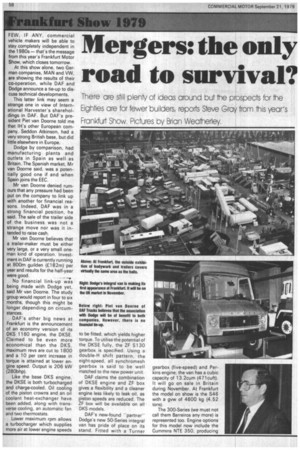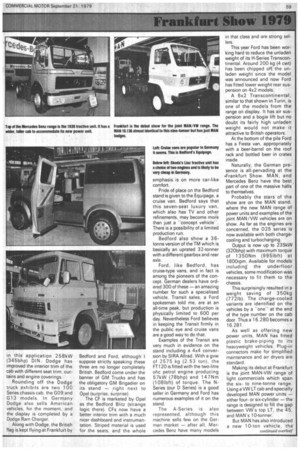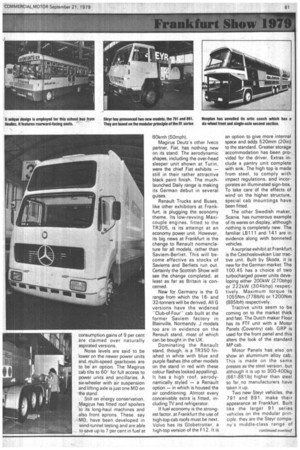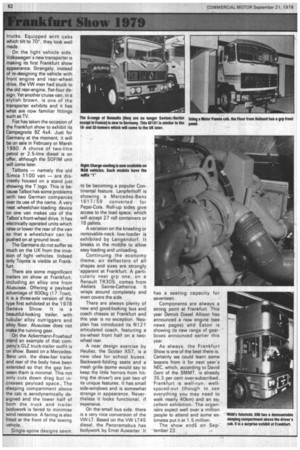Mergers:th only road to survival?
Page 60

Page 61

Page 62

Page 63

Page 64

If you've noticed an error in this article please click here to report it so we can fix it.
There are still plenty of ideas around but ne prospects for the Eighties are for fewer builders, reports Steve Gray from this year's Frankfurt Show. Pictures by Brian Wea erley.
FEW, IF ANY, commercial vehicle makers will be able to stay completely independent in the 1980s — that's the message from this year's Frankfurt Motor Show, which closes tomorrow, At this show alone, two German companies, MAN and VW, are showing the results of their co-operation, while DAF and Dodge announce a tie-up to discuss technical developments.
This latter link may seem a strange one in view of International Harvester's shareholdings in DAF. But DAF's president Piet van Doorne told me that IH's other European company, Seddon Atkinson, had a very strong British base, but did little elsewhere in Europe.
Dodge by comparison, had manufacturing plants and outlets in Spain as well as Britain. The Spanish market, Mr van Doorne said, was a potentially good one if and when Spain joins the EEC.
Mr van Doorne denied rumours that any pressure had been put on the company to link up with another for financial reasons. Indeed, DAF was in a strong financial position, he said. The sale of the trailer side of the business was not a strange move nor was it intended to raise cash.
Mr van Doorne believes that a trailer-maker must be either very large, or a very small oneman kind of operation. Investment in DAF is currently running at 800m guilden (£.182m) per year and results for the half-year were good.
No financial link-up was being made with Dodge yet, said Mr van Doorne. The study group would report in four to six months, though this might be longer depending on circumstances.
DAF's other big news at Frankfurt is the announcement of an economy version of its DKS 1160 engine, the DKSE. Claimed to be even more economical than the DKS, maximum revs are cut to 1800 and a 10 per cent increase in torque is attained at lower engine speed. Output is 206 kW (280bhp).
Like the base DKS engine, the DKSE is both turbocharged and charge-cooled. Oil cooling of the piston crowns and an oil coolant heat-exchanger have been added, along with transverse cooling, an automatic fan and two thermostats.
Lower maximum rpm allows a turbocharger which supplies more air at lower engine speeds to be fitted, which yields higher torque. To utilise the potential of the DKSE fully, the ZF S130 gearbox is specified. Using a double-H shift pattern, the eight-speed, all synchromesh gearbox is said to be well matched to the new power unit.
DAF claims the combination of DKSE engine and ZF box gives a flexibility and a cleaner engine less likely to leak oil, as piston speeds are reduced. The ZF box will be available on all DKS models.
DAF's new-found "partner" Dodge's new 50-Series integral van has pride of place on its stand. Fitted with a Turner gearbox (five-speed) and Perkins engine, the van has a cubic capacity of 13.2cum (471cuft). It will go on sale in Britain during November. At Frankfurt the model on show is the S46 with a gvw of 4600 kg (4.52 tons).
The 300-Series (we must not call them Barreiros any more) is represented too. Engine options for this model now include the Cummins NTE 350, producing in this application 258kW (345bhp) DIN. Dodge has improved the interior trim of the cab with different seat trim, curtains and engine coverings.
Rounding off the Dodge truck exhibits are two 100 Series chassis cab, the G09 and 013 models. In Germany Dodge also sells American vehicles, for the moment, and the display is completed by a Dodge Ram Charger.
Along with Dodge, the British flag is kept flying at Frankfurt by Bedford and Ford, although I suppose strictly speaking these three are no longer completely British. Bedford come under the banner of GM Trucks and has the obligatory GM Brigadier on its stand — ,right next to Opel (surprise, surprise) The CF is marketed by Opel as the Bedford Blitz (strange logic there). CFs now have a better interior trim with a much nicer dashboard and instrumentation. Striped material is used for the seats, and the whole emphasis is on more car-like comfort.
Pride of place on the Bedford stand is given to the Equipage, a cruise van. Bedford says that this seven-seat luxury van, which also has TV and other refinements, may become more than just a -concept vehicle-. There is a possibility of a limited production run.
Bedford also show a 36tonne version of the TM which is basically an uprated 32-tonner with a different gearbox arid rear axle.
Ford, like Bedford, has cruise-type vans, and in fact is among the pioneers of the concept. German dealers have ordered 300 of these — an amazing number for such a specialised vehicle. Transit sales, a Ford spokesman told me, are at an all-time peak, but production is physically limited to 600 per day. Nevertheless Ford believes in keeping the Transit firmly in the public eye and cruise vans are a good way to do that.
Examples of the Transit are very much in evidence on the stand including a 4-x4 conversion by SIRA Allred. With a gvw of 2575 kg (2.53 ton), the FT120 is fitted with the two-litre ohc petrol engine producing 57kW (78bhp) and 147Nm (108Ibft) of torque. The NSeries (our D Series) is a good seller in Germany and Ford has numerous examples of it on the stand.
The A-Series is also represented, although this machine sells few on the German market — after all, Mercedes Benz have many models in that class and are strong sellers.
This year Ford has been wor king hard to reduce the unladen weight of its H-Series Transcontinental. Around 200 kg (4 cwt) has been chipped oft the unladen weight since the model was announced and now Ford has fitted lower weight rear suspension on 4x2 models.
A 6x2 Transcontinental, similar to that shown in Turin, is one of the models from the range on display. It has air suspension and a bogie lift but no doubt its fairly high unladen weight would not make it attractive to British operators.
At the bottom of the pile Ford has a Fiesta van, appropriately with a beer-barrel on the roof rack and bottled beer in crates inside.
Naturally, the German presence is all-pervading at the -Frankfurt Show. MAN, and Mercedes Benz have the best, part of one of the massive halls to themselves.
Probably the stars of the show are on the MAN stand, where the new MAN range of power units and examples of the joint MAN/VW vehicles are on show. As far as the engines are concerned, the D25 series is now available with both chargecooling and turbocharging.
Output is now up to 235kW (320bhp) with maximum torque of 1350Nm (995Ibft) at 1600rpm. Available for models including the underfloor vehicles, some modification was necessary to fit them to the chassis.
This surprisingly resulted in a
weight saving of 350kg (7721b). The charge-cooled variants are identified on the vehicles by a "oneat the end of the type number on the cab door. Thus a 16.280 becomes a
16_281.
As well as offering new power units, MAN has fitted plastic brake-piping to its heavyweight vehicles. Plug-in connectors make for simplified maintenance and air dryers are standard.
Making its debut at Frankfurt is the joint MAN-VW range of light commercials which span the sixto nine tonne range. LlsIng a VW LT cab and specially developed MAN power units — either fouror six-cylinder — the range is designed to fill the gap between VVV's top LT, the 45, and MAN's 10-tonner.
But MAN has also introduced a new 10-ton vehicle, the continued overleaf
10.136F, which is based heavily around the co-operation range. It has the same cab, same engine and gearbox. Indeed, it is hard to see why this too is not called a MAN-VW but just MAN.
The answer, I would suppose, is that MAN already has a 10-tonner available in Germany, yet this is quite a heavyweight in comparison to the 10.136F vehicle. And the MAN-VW agreement is strictly for vehicles in weight categories not manufactured by either company. It is expected that the same basic cab will be used for vehicles possibly up to 16 tons.
At any show, there must be a show stopper and MAN's is the surprise exhibit of its X90 concept vehicle. This futuristic tractive unit, with its detachable sleeping compartment above the driving area, is very impressive-looking, though it must look rather strange when it is running solo — rather like a Marathon with a lump on top, as one observer unkindly described it! Also, rather incongruously, it is Shown hauling a container trailer, which is associated with short hauls while the vehicle is clearly designed for long hauls. Whether the 'concept' becomes a realistic project for future vehicle design, only time will tell.
Engine developments, especially for economy, are very much a theme at Frankfurt. Mercedes-Benz has launched two new power units. the OM 422 naturally aspirated unit, and OM 422 LA, charge-cooled and turbocharged, are developments of the V8 400 series with the capacity increased from 12.8 litres (781cuin) to 14.82 litres (892cuin).
Naturally aspirated, the 0M422 produces 106kW (280bhp) at 2300rpm and is claimed by Mercedes to be both
flexible and economical, rating alongside the best of turbocharged units. The 0M422 DA produces a mighty 2 76kW (375bhp) with 1550 Nm (11.43Ibft) torque and powers the flagship of the Mercedes range, the 1638.
To enable the new engine to be fitted, charges were needed to the -new generation" cab. These were largely needed to accommodate the charge
cooling and ancillaries. Although it is wider and in fact higher, the new cab is not noticeably bigger unless parked next to the regular cab. The interior space inside the 1638 is now indeed impressive.
The 206kW (280bhp) engine, for use in existing M-B vehicles, may now be specified
.coupled to either ZF
synchromesh eight-speed gearboxes or Fuller 13-speed constant-mesh. This, like the turbocharging of its V8, is a new departure for M-B.
Commenting at a M-B press conference, chairman of the Daimler Benz board of management, Professor J. Zahn, said he believed manufacturers should be allowed to do their own thing as far as making economical vehicles, rather than be hamstrung by governments. Mercedes-Benz, as well as other makers, had shown that economical units could be produced.
The Mercedes stand also has examples of that company's diverse range of vehicles, from the special twin-steer 2028 6x2 unit down to the Bremen van. This latter is now available with automatic transmission but, a spokesman told me, it is very unlikely that automatic versions will be coming to Britain — the demand is too small, he said.
Another vehicle which has been promised for the UK is the
G range. However, there is some doubt amongst M-B as to when it will arrive, and which models are to be imported. Rather than sell all types, M-B will probably go for the upmarket models and aim them at the huntin., shootin', 'n fishin' set.
The other major German maker, Magirus Deutz, also has turbocharged power units to supplement its naturally aspirated air-cooled engines. The BF8L413F develops 213kW (288bhp) DIN at 2300rpm while the BF10L413F puts out 265kW (360bhp) at the same rpm. Fuel consumption gains of 9 per cent are claimed over naturally aspirated versions.
Noise levels are said to be lower on the newer power units and multi-speed gearboxes are to be an option. The Magirus cab tilts to 60 for full access to power units and ancillaries. A six-wheeler with air suspension and lifting axle is just one MD on the stand.
Still on energy conservation, Magirus has fitted roof spoilers to its long-haul machines and also front aprons. These, say MD, have been developed in wind-tunnel testing and are able to save up to 7 per cent in fuel at 80kmh (50mph).
Magirus Deutz's other Iveco partner, Fiat, has nothing new on its stand. The aerodynamic shapes, including the over-head sleeper unit shown at Turin, were the chief Fiat exhibits — still in their rather attractive black paint finish. The muchlaunched Daily range is making its German debut in several guises.
Renault Trucks and Buses, like other exhibitors at Frankfurt, is plugging the economy theme. Its low-revving Maxicouple engines, fitted to the TR305, is its attempt at an economy power unit. However, its big news at Frankfurt is the change to Renault nomenclature for all models, rather than Saviem-Berliet. This will become effective as stocks of Saviems and Berliets run out. Certainly the Scottish Show will see the change completed, at least as far as Britain is concerned.
New for .Germany is the G range from which the 16and 32-tonners will be derived. All G versions have the widened -Club-of-Four" cab built at the former Saviem factory in Blainville, Normandy. _1 models too are in evidence on the Renault stand, most of which can be bought in the UK.
Dominating the Renault stand, though, is a T8350 finished in white with blue and purple flashes (the other models on the stand in red with these colour flashes looked appalling). It has a high roof, aerodynamically styled — a Renault option — in which is housed the air conditioning. Almost every conceivable extra is fitted, including TV and refrigerator.
If fuel economy is the strongest factor, at Frankfurt the use of high-top cab roofs must be next. Volvo has its Globetrotter, a high-top version of the F12. It is an option to give more internal space and adds 520mm (20in) to the standard. Greater storage accommodation has been provided for the driver. Extras include a pantry unit complete with sink. The high top is made from steel, to comply with impact regulations, and incorporates an illuminated sign-box. To take care of the effects of wind on the higher structure, special cab mountings have been fitted.
The other Swedish maker, Scania, has numerous example of its wares on display, although nothing is completely new The familiar LB111 and 141 are in evidence along with bonneted vehicles.
A surprise exhibit at Frankfurt. is the Czechoslovakian Liaz tractive unit. Built by Skoda, it is new for the German market. The 100.45 has a choice of two turbocharged power units developing either 200kW (270bhp) or 222kW (304bhp) respectively. Maximum torque is 1055Nm (778Ibft) or 1200Nm (885Ibf1) respectively.
Tractive units seem to be coming on to the market thick and fast. The Dutch maker Floor, has its FTF unit with a Motor Panels (Coventry) cab. GRP is used for the front panel and this alters the look of the standard MP cab.
Motor Panels has also on show an aluminium alloy cab. This is made on the same presses as the steel version, but although it is up to 300-400kg (661-8811b) higher than steel so far no manufacturers have taken it up.
Two new Steyr vehicles, the 791 and 891, make their appearance at Frankfurt. Built like the larger 91 series vehicles on the modular principle, they are the Steyr company's middle-class range of trucks. Equipped with cabs which tilt to 70c, they look well made.
On the light vehicle side, Volkswagen's new transporter is making its first Frankfurt show appearance. Strangely, instead of re-designing the vehicle with front engine and rear-wheel drive, the VW men had stuck to the old rear-engine, flat-four design. Yet another cruise van, in a stylish brown, is one of the transporter exhibits and it has what are now familiar fittings such as TV.
Fiat has taken the occasion of the Frankfurt show to exhibit its Campagnola BZ 4x4. Just for Germany at the moment, it will be on sale in February or Marsh 1980. A choice of two-litre petrol or 2.5-litre diesel is on offer, although the SOFIM unit will come later.
Talbots — namely the old Simca 1100 van — are discreetly housed on a stand just showing the T logo. This is because Talbot has some problems with two German companies over its use of the name. A very neat wheelchair-loading device on one van makes use of the Talbot's front-wheel drive. It has electrically operated units which raise or lower the rear of the van so that a wheelchair can be pushed on at ground level.
The Germans do not suffer as much on the UK from the invasion of light vehicles. Indeed only Toyota is visible at Frankfurt.
There are some magnificent trailers on show at Frankfurt, including an alloy one from Alusuisse. Offering a payload advantage of 900kg (17.7cwt), it is a three-axle version of the type first exhibited at the 1978 Geneva Show. It is a beautiful-looking trailer, with tubular alloy outriggers and alloy floor. Alusuisse does not make the running gear.
On the Ackermann-Fruehauf stand an example of that company's GLZ truck-trailer outfit is on show. Based on a Mercedes Benz unit, the draw-bar trailer and rear of the body have been extended so that the gap bet ween them is minimal. This not only cuts down drag but increases payload space_ The :sleeping compartment above the cab is aerodynamically de
signed andand the lower half of .both the truck and trailer bodywork is faired to minimise
wind resistance. A fairing is also fitted at the front of the towing vehicle.
Single-spine designs seem to be becoming a popular Continental feature. Lanpferhoff is showing a Mercedes-Benz 1617/59 converted for Pepsi-Cola. Roll-up sides give access to the load space, which will accept 27 roll containers or 18 pallets.
A variation on the kneeling or removable-neck low-loader is exhibited by Langendorf. It breaks in the middle to allow easy loading and unloading.
Continuing the economy theme, air deflectors of all shapes and sizes are strongly 'apparent at Frankfurt. A particularly neat grp one, on a Renault TR305, comes from Ateliers Sainte-Catherine. It wraps around completely and even covers the side.
There are always plenty of new and good-looking bus and coach chassis at Frankfurt and this year is no exception. Neoplan has introduced its N121 articulated coach, featuring a six-wheel front half on a twowheel rear.
A near design exercise by Heuliez, the Scolair X57, is a new idea for school buses. Backward-folding seats and a mesh grille (some would say to keep the little horrors from hitting the driver!) are just two of its unique features. It has small side-windows and is somewhat strange in appearance. Nevertheless it looks functional, if expensive.
On the small bus side, there is a very nice conversion of the VW-LT. Based on the VW LT45 diesel, the Panoramabus has bodywork by Ernst Auwarter. It has a seating seventeen. capacity for Components are always a strong point at Frankfurt. This year Detroit Diesel Allison has announced a new engine (see news pages) and Eaton is showing its new range of gearboxes announced earlier this year.
As always, the Frankfurt Show is one of the best there is. Certainly we could learn some lessons from it for next year's NEC, which, according to David Gent of the SMMT, is already 35.3 per cent over-subscribed. Frankfurt is well-run, wellspaced-out (though to see everything you may need to walk nearly 40km) and an excellent exhibition. The organisers expect well over a million people to attend and some estimates put it at 1.5 million. The show ends on Sep: tember 23.












































































































































